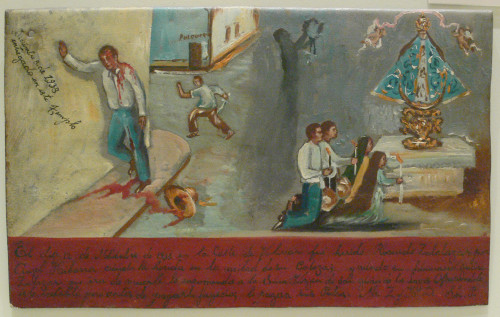
Mexican retablo, 1935. “Our Lady of San Juan de los Lagos”. (Andreas Praefcke, photo).
“Men relate to each other, but they do not see each other.”
Max Horkheimer
“Our unconscious has as little use now as it ever had for the idea of its own mortality.”
Sigmund Freud
The notion of exile has shadowed much of 20th and 21st century history. The resonance of exile, though, is predicated on a genuine sense of home, of that place from which one is sent into exile. I was struck recently, as I sat in our cabin here in central west Norway, when I looked at two photographs of California. One was just a snapshot of Los Angeles, K-town, at twilight, and the other was just a real estate photo of a nice mid century house located out in the further reaches of the San Fernando Valley. Neither were particularly remarkable photographically, but I am from Los Angeles. The photograph of the home in, I think Agoura Hills, was generic even, but it was a sunny day, a summer day, and because I grew up in Southern California, I could remember the feel of summer days, the San Fernando Valley, of Eucalyptus trees, of scrub oak, box elder, willows, and various succulents that people like to plant on their property. The hillside behind the house was mostly typical “soft chaparral”, laural sumac, and mulefat. There is no canopy of trees in the Sepulveda basin, or ‘the valley’. Never was I don’t think. Eucalyptus, blue gum and red gum, are not native to so-cal, but they are deeply ingrained in the imagination of Californians. Eucalyptus came to So cal, actually, in the 1860s. The first stand were planted on what is now the Los Angeles County Arboretum. Abbot Kinney, a wealthy tobacco magnate was also for a few years the State Forester and promoted the planting of Eucaplyptis. The 10 Freeway heading out to the desert still is lined in places with aging blue gum Eucaplytpis (near Colton and Fontana). One cannot find many photos of southern California in the early 20th century that wont include a Eucalyptus. As a side bar of sorts; they came to be seen, by the 1960s, as too invasive, and were blamed in fact for a couple fires (most notably the Bay area fire of 1991. In fact, the fault was with over development, and too many homes). But the Eucalyptus’ fate was to be associated with the less than ritzy and somehow inelegant. I doubt seriously too many landscapers today, in the world of gentrification, would plant Eucalyptus. Anyway, the point is that my childhood and youth is deeply informed by Eucalyptus trees, by the bark, as it fell on grass and dirt, peeling off trees. The heat of summer in ‘the valley’ can be intense, and air quality bad. But none of that matters because my sense of home includes all of that, though it recedes, leaving palm trees and freeways, Eucalyptis and palms.
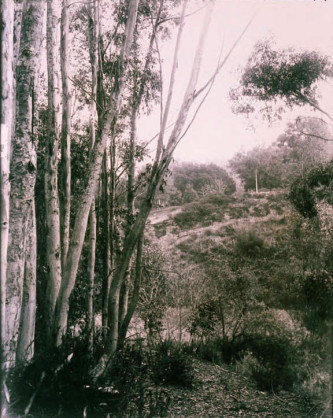
Eucalyptis trees, Rustic Canyon, Santa Monica, 1920.

Robert Adams, photography.
The faux history that Hollywood promotes, and hacks like James Ellroy, is a white fantasy. El Lay was never really what one saw in film. The film industry imprint is huge, but it was always contained. That was Hollywood. There were some writers who captured the other El Lay — James Cain was one, but not many. If you read Chandler, you realize he grasped it, too. Charles Burnett’s masterpiece Killer of Sheep captured something of the truth of L.A. But the glosses on Chandler emphasize the *style* and leave out the dark social pessimism. Mike Davis, my friend Leon Bing, Luis Valdez in his seminal play Zoot Suit, are all transcribing something of a real experience of Southern California. (to see how horrifying the coverage of LA can be, see the New York Times here http://www.nytimes.com/2015/05/03/style/los-angeles-and-its-booming-creative-class-lures-new-yorkers.html?_r=0).
When I was a young boy you could drive south on Pacific Coast Highway and see only Orange groves. Or drive out past Palm Springs (and there was ONLY Palm Springs) and hit thousands of acres of date farms. Date palms blanketed what is now an Indio of strip malls and cheap low end apartment buildings. The mythology of Hollywood was real, but it was only a fraction of the reality of growing up in So Cal. The world of studios was an island in a Mexican and immigrant nation of steel plants, tire manufacturers, farming and even oil. Wyatt Earp lived in LA, my father remembered. Earp died in a bungalow off West Washington Blvd in 1929. That was the sense I had as a boy, driving out into San Bernadino County, to date farms (Earp was honorary sheriff of the county, in the 1920s and had lived in Vidal) and the retired farm hands and railroad men. The railroads were still a big part of the landscape and aura of southern California in the 1950s. Virgil Earp and Morgan, both lived in Colton, in the early part of the 20th century. The backdrop for the Los Angeles I grew up in was one of stories told about railroad robbers, of various bandits and of the history of a California that was still tied more directly to Mexico. Men who had fought in the Revolution. Fought with Villa. Men who knew men who claimed to have known Joaquin Murrieta. And the Baja was always just south, a defacto buriel ground for memory, an ominous desert whose alluvial plain sloped down to the strange waters of the Sea of Cortez. Nobody really lived south of Tijuana in those days. Kem Nunn has written of the San Diego/Tijuana border region, and of south Orange County. The early iconoclastic surf culture of those many tiny towns that once existed off PCH. There is an Indian Reservation there, too. Later, a suburban version of Surfing took hold. The aqua jock white Huntington Beach version. As a teen, I recall always wanting to avoid those guys. Too unpredictable, too violent. I never felt that way in South Central, or Watts. There was a survivalist logic in the black urban centers. The white beach proletarian/middle lacked a logic. There was no cultural backdrop, nothing but disposability. Pyschic disposability. A planned cultural obsolescence.

Ryan Mathieson, photography. Mojave/Sonoran desert.
Children absorb the world around them in ways that are, increasingly, programmed today. The programming starts around junior high school and never abates. In certain respects it starts in kindergarten. This is the real tragedy of the generalizing trend in contemporary culture. The homogenized commercial blandness that is absent any specific origin. The Muzac culture. I wonder do children born in the last ten years experience their childhood with the same specificity that older generations have, do they hear the shifting dialects that exist often within a single city. Is there a sense of food that is genuinely signaled out as belonging to their neighborhood. The only places where *home* means anything is the underclass. The tendency has been for the bourgeoisie to scrub their origins away, excepting the markers for class. Ben Affleck’s attempt to erase his family’s slave owning past is almost rather pathetic. Why did he have such a response?
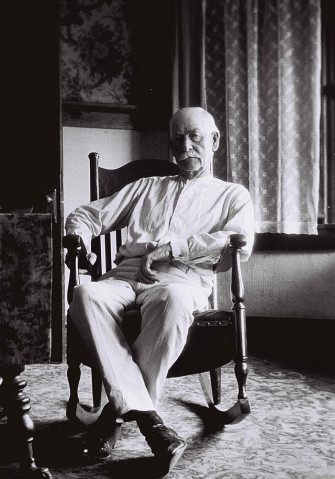
Wyatt Earp, age 75, in Los Angeles apartment. (Photo by John Flood Jr.)
David Shields writes: “Cinema verite doesn’t make a clear enough distinction between fact and truth — as if facts constituted the truth –but there’s quite a distinction.”
Indeed. Shields adds that “I see every art as importantly documentary. Everything is always already invented; we merely articulate, arrange.” I sense that the absence of real authorship in improvised dialogue relates to some actual lack in me. But more, what I hear in improvisation is only the sound of anxiety. The anxiety and nerves of the performer. Which takes us back to the idea of actors playing roles, playing a character. But nobody is attempting to fool the audience. They know it’s an actor. So what is the actor doing then? The actor is reciting text. He is performing a text. He or she is performing a *memorized* text. The problem begins when this ritual is approached from the perspective of ‘character’ — as if that character were a clear solid unchanging *thing*. I swear to tell the truth, the whole truth, and etc.

Descansos — roadside shrine, Baja California 2014. (photo : Morosecupcake).
But Shields says one other thing I wanted to note: when he asks how much can be removed from a narrative, an artwork, and still have it be intelligible. He cites Chekov, for removing plot, Pinter removed the personal history and Beckett the characterization. Argue with that if you want (I would) but then he says; “We hear it anyway, omission is a form of creation”. And this is correct. We hear it anyway. And this is a crucial aspect of arts education that is absolutely neglected. For this is only understood if one accepts the idea that ‘everything’ is a form of autobiography, and that autobiography is fiction. Of a sort, anyway. Here we reintroduce this idea of accuracy again. I swear to tell the truth, the whole truth and nothing but the truth. If I only knew what the truth was.
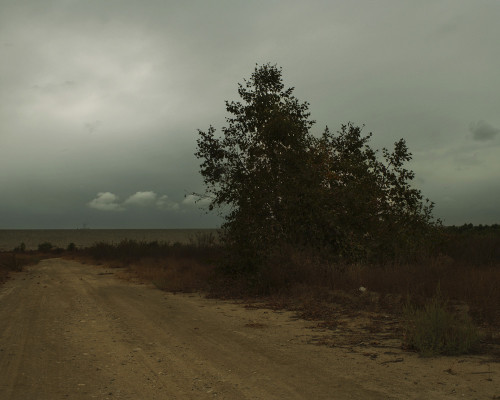
Alia Malley, photography. ‘Los Angeles, Irwindale’.
Herbert Blau once wrote that even in theatres without curtains, we remember, and the theatre remembers (!) that the curtain was once there.
Freud said that nobody wrote to achieve fame. That we wrote for ourselves. Thinking again of Paleolithic cave art, it is worth wondering if any version of fame existed, and I’m not being facetious. The very idea of the unconscious is connected at its core in a relation of self and other. The spatial models tend to get in the way of really understanding this because it is hard to write without recourse to ‘inner and outer’. The reality is closer to some form (as Samuel Weber puts it) of dislocation in the subject. In a sense then, writing for your self is writing for another, and writing for another is, then, writing for yourself. It’s a way of finding yourself. This is also a link to Wittgenstein, who was always interrogating how language worked out a functionality that pointed toward the parameters of meaning. The super-ego then, as an ideal that can never be attained (for that *is* what it is in service to do) helps to navigate some inter-psychic dynamic that identifies what it is not. This also is a way to bring this posting back to the topic of exile. But first, it requires that there be some discussion of foreignness. The archaic narcissistic self, that which precedes the material world, already projects outward what is unpleasant and frightening in itself. The ‘other’ as double is then a repository for menacing feelings. But this ‘other’ is a double, too. A doubled double. There are a host, probably, of substitutions going on in all this. For the purposes of this post the point is really that there is a gulf that separates the self from this other. This abyss (Kristeva) shocks me, and any confrontation with this ‘foreigner’ must be rejected, out of fear, out of self preservation.
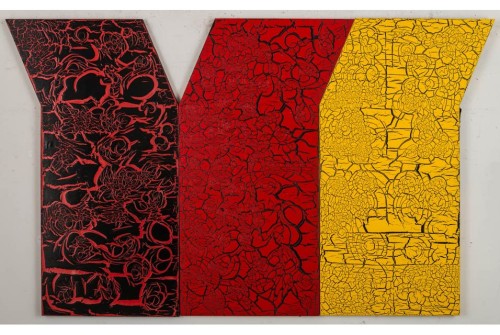
Ed Moses
The entirety of narrative is fictitious, but it is also truthful. The writer desires to tell the truth, to express something of the truth of what is experienced. But finding the truth is not the same as measuring ,weighing, counting, testing or establishing formulas. It is enchantment. Hence fairy tales, etc. And because it is personal, it is always a form of reverie. And reverie is always about our memory of origins. Storytelling was born not because it provides data. Freud saw the uncanny linked to a certain lascivious fantasy/memory — inter-uterine, in which homesickness has its origin. Perhaps so, but whatever truth one allows this, homesickness is reproduced later in certain experiences of love. Our early memories, childhood memories are always tinged with something uncanny. My own reverie about my childhood in Los Angeles is partly melancholy, and painful. Homesickness is also about regret, and about loss. Or rather, the realization, with age, of the loss of the possibility to have further loss of this sort. Regret is always reconstruction of mimetic narratives. It is not what *really* happened so much as what we wished at the time ‘would’ happen, would have happened. What didn’t happen. The memory of our desire.
What are the effects of increasingly homogenized childhoods? Where everyone’s origin is the same.
There is another aspect to exile, speaking psychoanalytically, and that is to grow up under occupation. The children of poverty in the U.S., for example, construct their narratives of self under the real eye of an occupying army. Surveillance of all kinds serve to create an anguish in those observed, for whom such menace is acute, and hence subsumes the mimetic, almost. The memory of threat being real, the narratives one employs to survive, psychically, are ones of a fear of identification. The relationship to the ‘other’ is one of having to internalize one’s own illegitimacy. The fear is of identification because it is an identification with illegitimacy. Whether is it the Arab in Europe, the black in the U.S.; the origin memory is mediated. If one is born in Marseilles, then one is French. Except not. The black youth in Baltimore feels something like the acute suffering of origin because it is connected to slavery. I am born in the former slave port. The other *might* be the slave owner. Might be the ‘Indian killer’, or bounty hunter. Or Pinkerton thug. Illegitimate. The underclass is always aware of a gaze that criminalizes. It is safer to be invisible.
It is as if the more acceptable tensions that come of experiencing the uncanny are short circuited. Exile while at home. Foreignness at home. The exile without a memory of home. The reverie is then shadowed by the gaze of those connected to the occupier. The child of the relatively homogenized, then, will also take on the role of judgement. The oppressed must become invisible. The oppressor must become judge and warden.
“Disturbed innerness is the courtiers’ lot…”
Kristeva

Rosa Muerte, Joshua Tree. Robert Stone, architect (LA Casa Park, photo).
The children of privilege, of white advantage, are therefore handed a role of in which they feel helpless to *not* become the prosecution in this inter-psychic trial. Discourse in contemporary Western society, especially the U.S., uses a grammar of punishment, of judgement, and of an idea that this pathological depersonalized self is actually an ideal, is heroic. The psychic dynamics are now relentlessly expressed in this highly militarized vocabulary, and the framing of it in the subject of those who belong, is one of combativeness and quarrel. The meaning of words has shifted, the syntax, so that the aggressor is always present, even if just in how clauses are ordered. At what point historically did this *other*, this rivalry even, take on a murder-bearing ruthless reaction. It is interesting to think back to Greek tragedy, and then Shakespeare. In the Greeks it is possible to see the war of Dionysian and Apollonian perhaps, and by Shakespeare, the battle is lost, and something is being transcribed that is another order of Tragic. The tragedy is now ourselves. The regret is colored with pessimism. The drama starting with Shakespeare is perhaps the start of dramatic narration as recuperation. This is far too facile, and certainly it is not a direct clear line to the present. But for the black population in the U.S., the history of slavery has not just magically been cleansed from the psyches of U.S. citizens. Baltimore was a slave port in fact. The ghosts of those atrocities live on in how words are used and chosen. Which words become archaic, which rise up. The middle ages were crucial is objectifying this psychoanalytical process. Kristeva points out the idea of *foreigner* was given legal definitions. It also become associated with the kingdom, rather than the local land owner. The law, and jurists, were creating a language for foreignness and gradients thereof. The measuring of degrees of legitimacy, or illegitimacy, of foreignness.
The borders the exile crosses are also reflections of (or vice versa) of the spatial territorializing of the psychoanalytic model.
As Borch-Jacobson wrote (on Lacan); “In short, it is the competitive, rivalrous world, revealed as the great traditional ordering principles retreat, a world of doubles all the more identical for assuming their autonomy, all the more racked by guilt for declaring their emancipation from every law.” Contemporary society, adrift from symbolic fathers, but with emerging super-power super-egos are, as Rob Weatherill points out…“The archaic super ego becomes an undercover double agent infiltrating the criminal underworld, death squad, the masked hit man, the contract killer, to *take out* what is already dead.” The narrative figure of the stranger is today become a legal category. The super power super-ego is now far exceeding the mental agency mandate. The rogue super ego.

Richard Ross, photography. Santa Barbara High School, 2nd floor corridor. California.
The foreigner is within us, and the appearance of foreignness, certainly officially designated foreignness, arouses an ambivalence for the foreign is our repressed selves. Those who have taken on as part of their identity a deep identification with their job, as extension of official institutions then must experience otherness as not just threatening, but accompanied by revulsion. The identification with one’s own alienation requires much sublimation. The identification with corporate authority demands swallowing too much, too many lies. It will make you sick. The revulsion the ruling class feels for the foreign — is the fictionalized narrative of that double, returned to expose the terror of an unstable identity. Those with ‘papers’ are really the ones who know they are forged. All identity papers are forged in the end. The ruling class revulsion is different than the clerks of Empire who wait on them. But both of them share a perspective that looks down from the citadel to the peons and serfs, and slaves, below. This happens on micro and macro levels. The recent Jeremy Clarkson firing from the BBC was illustrative of white male spite and self loathing. Clarkson is one of those very tall men, who is also soft. He has spent a lifetime looking down on everyone (clearly including wives) and yet, he is not powerful, his size only emphasizes a squelchy doughy physique. That softness is filled with contempt. His racism is against the outisder, the threat to his vast privilege, but a privilege of which he knows he does not deserve.
Ive written a lot in the past about the creation of authoritarian space. The photo above of the high school in Santa Barbara is by Richard Ross. The entire photo essay is here. It’s rather brilliant. http://richardross.net/architecture-of-authority-c8ac7

Joaquin Murrieta, apprx. 1850s.
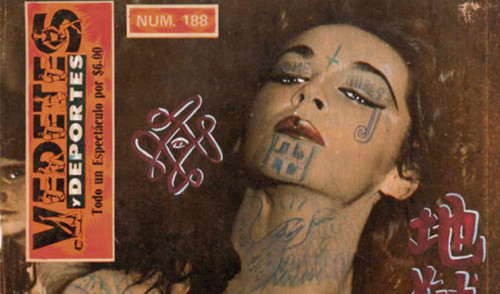
Dr. Lakra
The white privileged class desires now, the familiarity of depersonalization. The popularity of Zombie films and TV is a mirror of what these viewers know themselves to be. Zombies are both representations of a threatening horde of poor, and a reflection of repressed recognition and identification. The wholesale slaughter of zombies that takes place in most film and TV zombie tales, reinforces this idea, paradoxical as it may first seem. The ruling class sees the poor from a vantage point on high (see Jeremy Clarkson above, again) and project their own toxins and fear outward with the resultant zombiefication of the masses. But on another level, the ruling elite know their core selves are foreign and strange, toxic, for their identification is with a missing father, with authority in the form of institutional deadness. And behind the mask lies the face of the whipped cur. They cannot negotiate with their ideal ego. The terror is being asked to take off the mask. But, additionally, Weatherill makes a cogent point here about the pleasure of attacking fathers and symbolic fathers today. “Currently there is an orgy of exposing him to ridicule…” Indeed, the taking down of great men syndrome. Mao didn’t brush his teeth, Freud used coke, Marx beat his wife, or was that Tolstoy? Gandhi was petulant, Heidegger was a Nazi. Now, this is not the same as making clear that, yes, Heidegger’s thought is largely fascistic. Gandhi did have some unpleasant aspects to his work. The point is the enjoyment of this character assassination. I have said before, the left today far too often resembles a psychological version of the death squads they critique. They are the Jonathan Edwards and Oliver Cromwells of ideological analysis. This is a dangerous zone, a dangerous aspect of failed self examination. It is like everyone is one’s own personal expulsion committee of one…kicking oneself out of the party.
Additionally, though, this touches on memory. The recovered memories inquisition was only an exteriorizing of what was already going on. The identification with the machine… literal and metaphorical. (Terminator 1 and 2). In another lifetime Jeremy Clarkson would have been attache to Chinese Gordon. Or a middle rank minister of the Raj. Or, a plantation owner. The plantation owner who convinces himself he has only the best interest of his slaves at heart. There is a desperation in the ownership class that senses their own counterfeit identity. The recovered memories debacle was never about concern for children. It was always about the opportunity to burn witches at the stake. For the rest of us, the sense of place, memory, and the complex melancholia of origin, is being stolen. Those reveries are the foundational principle for the imagination. That is how one develops a personal vision of the world, rather than a homogenized pre-fabricated one. One pre fabricated where everyone speaks in the voice of the colonizer. It is like showing up at the party with the same dress or tie as the person next to you, when the salesperson promised they were one of a kind. There is a new terrorizing of inner life by a system of constant erasure and manipulation. And repetition.
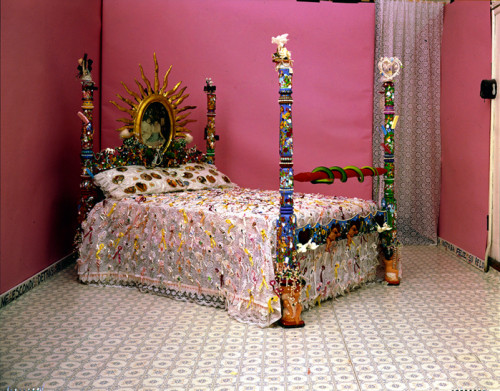
Pepon Osorio
Here is a quote from a professor at New York University…and no this is not satire.
“Much contemporary art—not to mention fiction, film, and television—reflects a Blade Runner vision of a world, in which the individual is rendered powerless by anonymous government agencies, giant corporations, and deafening mass culture. It’s useful to remember that this nightmare vision is itself a romantic stereotype, ignoring the positive aspects of postmodern society. Since 1980, the number of people living in extreme poverty has declined dramatically, both as a percentage of world population and in absolute numbers. The principal reason is the globalization of the economy, which has created millions of factory jobs in the former Third World, lifting workers from starvation in the countryside to subsistence in the cities.”
Pepe Kamel
It is hard to imagine how such stupidity reaches the level of institutional sanction and authority. One barely knows where to begin explaining to Mr Kamel the nature of those factory jobs. But again, this is presumably a man who is educated and yet his only cultural referent is a Hollywood studio film. The post modern world is just a happy place and those sweat shops and Maquiladoras are making folks prosperous and happy. Here is a web page with useful information on Maquiladora worker solidarity and resistance. http://sdmaquila.blogspot.no/
Here is another example of problematic thinking …in this case represented by curatorial notes for the “LA Project” at UCCU. To introduce one of the artists; Kaari Upson.
“Since receiving her MFA from CalArts in 2007, Kaari Upson (b. 1972, San Bernardino, California) has focused on a single set of works: “The Larry Project.” After discovering boxes full of journals, photographs, and other personal items belonging to the eponymous man in a burned-down home, Upson dedicated the next seven years to learning–and eventually fabricating—a history of Larry: the quintessential 70s and 80s wannabe playboy, a devotee of Hugh Hefner and self-help therapies, disillusioned with materialism yet enamored with his luxury car and home. She created a personality profile based on his handwriting, had their astrological signs analyzed for compatibility, made a doll of him with which she had a relationship. Her obsession led to creative disassociation as she tried to become Larry. She would enact his fantasies and project his desires through a series of sculpture, installation, video, and performance pieces until the subjectivities of Larry and Kaari, history and fiction collapsed. Upson’s UCCA presentation includes a set of mattresses, cushions, couches, and other objects molded in silicon and displayed within an environment designed by the artist. The give and take of flesh is displaced onto the press of molded silicon as it seeps into the body of the furniture, itself the locus of communication and connection between the Self and the Other.”
One can sense the string of wrong headed decisions involved in Ms Upson’s creative work, but also in the cringe worthy gallery copy. In the same show another artist is said to be exploring ideas of identity. Whenever an artist is said to be exploring “identity”, one knows its going to be bad. Artists are not *exploring* abstractions…gender, identity, modern life, etc. This the default pablum of the MFA grad who got the job scripting something to throw in the catalogue for the show.
“A connection is commonly drawn between the development of psychology and the rise of the bourgeois individual, both in Antiquity and since the Renaissance. This ought not to obscure the contrary tendency also common to psychology and the bourgeois class, and which today has developed to the point of excluding all others: the suppression and dissolution of the very individual in whose service knowledge was related back to its subject.”
Adorno

Great piece John! Just wanted to share this link:
http://www.thenation.com/blog/206121/game-done-changed-reconsidering-wire-amidst-baltimore-uprising
I love that you’ve made those points from the very beginning about the regressive nature of “The Wire”. Yet ability to read text is truncated such that most people are just blind to it. And now the MSM comes up with an op-ed like that — doing the whole “realization” thing in a completely half-assed and softened manner.
“Earp died in a bungalow off West Washington Blvd” – fabulous. required some web searching: He died at 4004 W. 17th Street – near Washington & Crenshaw. Had tried to get the studios interested in his bio for silent films, seems w/out much luck. But did become friends with early western film stars William Hart and Tom Mix, who attended his funeral – one serving as pallbearer. (The facsimiles burying the real?)
Obituary in the Los Angeles Times said, “…it was like a reunion of the sturdy men and women who knew Wyatt as a wiry, six-foot, two-gun officer of the law in mining town, cow camp and almost anywhere along the frontier where trouble was apt to pop loose.”
Interesting, “reunion of sturdy men and women” — the nostalgia then and the nostalgia now…a chain of interconnecting nostalgia. “two gun officer” – yet another mythic image of preternatural authority.
(Wyatt Earp source: http://www.westadamsheritage.org/read/471#sthash.IE8ppn8K.dpuf)
Interesting reference to Kaari Upson. Writing biographies is a very creepy experience. Once you go through their garbage and journals and shopping lists and all the sordid affairs of their life, you get a peculiar feeling of having left yourself behind. You’re in a place you don’t belong, like Mars, and you’re all alone. It’s the loneliest feeling in the world. Then the writing gets to be about you, but from the outside in. You peer at what you’ve written and realize it’s you. But it’s startlingly close, more so than anything you could have written directly about yourself. I think the only way to yourself is through the stories of others. A good thing too or nobody would watch movies or plays or read novels.
I agree Kevin. Interesting note.